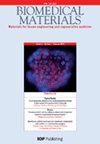用于磷酸钙骨水泥早期降解和骨再生的快速溶解葡萄糖多孔原
IF 3.7
3区 医学
Q2 ENGINEERING, BIOMEDICAL
引用次数: 7
摘要
在这里,我们证明了葡萄糖微粒(gmp)在磷酸钙水泥(CPCs)中作为气孔原的体内有效性,以获得快速降解的骨替代材料。在两个不同GMP尺寸范围(100-150 μm (GMP- s)和150-300 μm (GMP- l))中添加20 wt%的GMP制备复合材料,而含有20 wt%聚乳酸-羟基乙酸微颗粒(PLGA)的CPC和普通CPC作为对照。植入大鼠股骨髁缺损模型2周和8周后,取标本进行材料降解和骨形成分析。组织学上,未观察到任何cpc制剂的不良组织反应。与普通CPC对照相比,所有CPC-多孔素制剂的降解速度更快,但只有含有gmp的制剂与普通CPC对照相比,新骨形成量更高。8周后,与普通CPC对照相比,只有含有GMP-S或PLGA孔隙剂的CPC-孔隙剂配方的降解率更高。总体而言,将gmp纳入CPCs可形成大孔结构,最初可加速新骨的生成。这些发现强调了一种新方法的有效性,该方法利用简单的多孔性来生成具有不同降解和骨再生特征的多孔cpc。本文章由计算机程序翻译,如有差异,请以英文原文为准。
Fast dissolving glucose porogens for early calcium phosphate cement degradation and bone regeneration
Here, we demonstrate the in vivo efficacy of glucose microparticles (GMPs) to serve as porogens within calcium phosphate cements (CPCs) to obtain a fast-degrading bone substitute material. Composites were fabricated incorporating 20 wt% GMPs at two different GMP size ranges (100–150 μm (GMP-S) and 150–300 μm (GMP-L)), while CPC containing 20 wt% poly(lactic-co-glycolic acid) microparticles (PLGA) and plain CPC served as controls. After 2 and 8 weeks implantation in a rat femoral condyle defect model, specimens were retrieved and analyzed for material degradation and bone formation. Histologically, no adverse tissue response to any of the CPC-formulations was observed. All CPC-porogen formulations showed faster degradation compared to plain CPC control, but only GMP-containing formulations showed higher amounts of new bone formation compared to plain CPC controls. After 8 weeks, only CPC-porogen formulations with GMP-S or PLGA porogens showed higher degradation compared to plain CPC controls. Overall, the inclusion of GMPs into CPCs resulted in a macroporous structure that initially accelerated the generation of new bone. These findings highlight the efficacy of a novel approach that leverages simple porogen properties to generate porous CPCs with distinct degradation and bone regeneration profiles.
求助全文
通过发布文献求助,成功后即可免费获取论文全文。
去求助
来源期刊

Biomedical materials
工程技术-材料科学:生物材料
CiteScore
6.70
自引率
7.50%
发文量
294
审稿时长
3 months
期刊介绍:
The goal of the journal is to publish original research findings and critical reviews that contribute to our knowledge about the composition, properties, and performance of materials for all applications relevant to human healthcare.
Typical areas of interest include (but are not limited to):
-Synthesis/characterization of biomedical materials-
Nature-inspired synthesis/biomineralization of biomedical materials-
In vitro/in vivo performance of biomedical materials-
Biofabrication technologies/applications: 3D bioprinting, bioink development, bioassembly & biopatterning-
Microfluidic systems (including disease models): fabrication, testing & translational applications-
Tissue engineering/regenerative medicine-
Interaction of molecules/cells with materials-
Effects of biomaterials on stem cell behaviour-
Growth factors/genes/cells incorporated into biomedical materials-
Biophysical cues/biocompatibility pathways in biomedical materials performance-
Clinical applications of biomedical materials for cell therapies in disease (cancer etc)-
Nanomedicine, nanotoxicology and nanopathology-
Pharmacokinetic considerations in drug delivery systems-
Risks of contrast media in imaging systems-
Biosafety aspects of gene delivery agents-
Preclinical and clinical performance of implantable biomedical materials-
Translational and regulatory matters
 求助内容:
求助内容: 应助结果提醒方式:
应助结果提醒方式:


